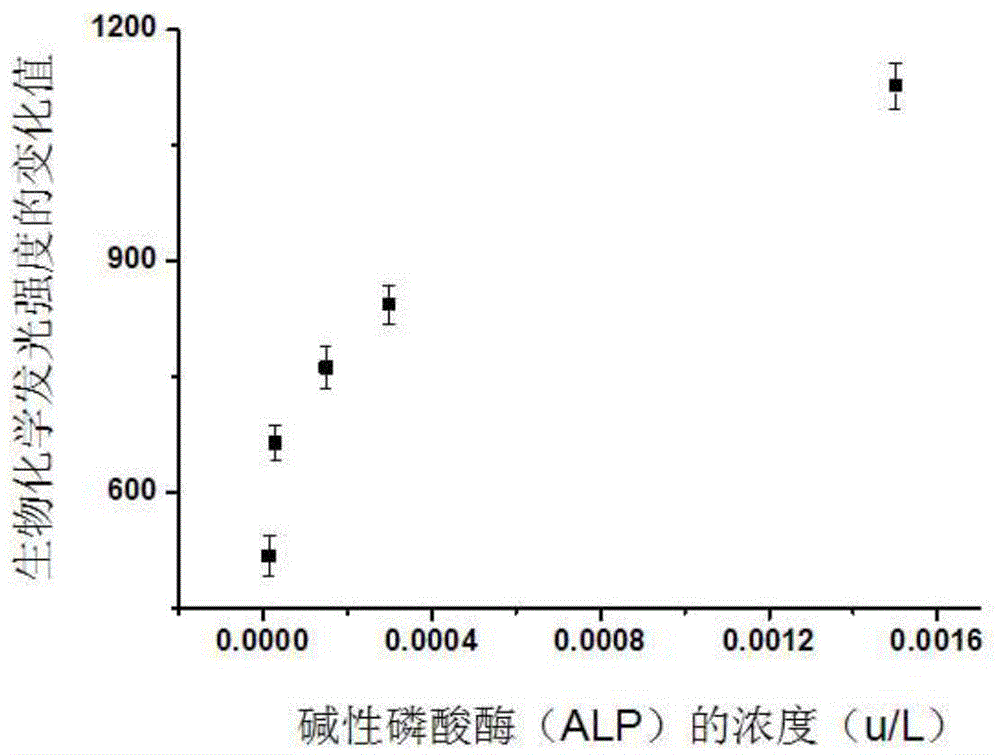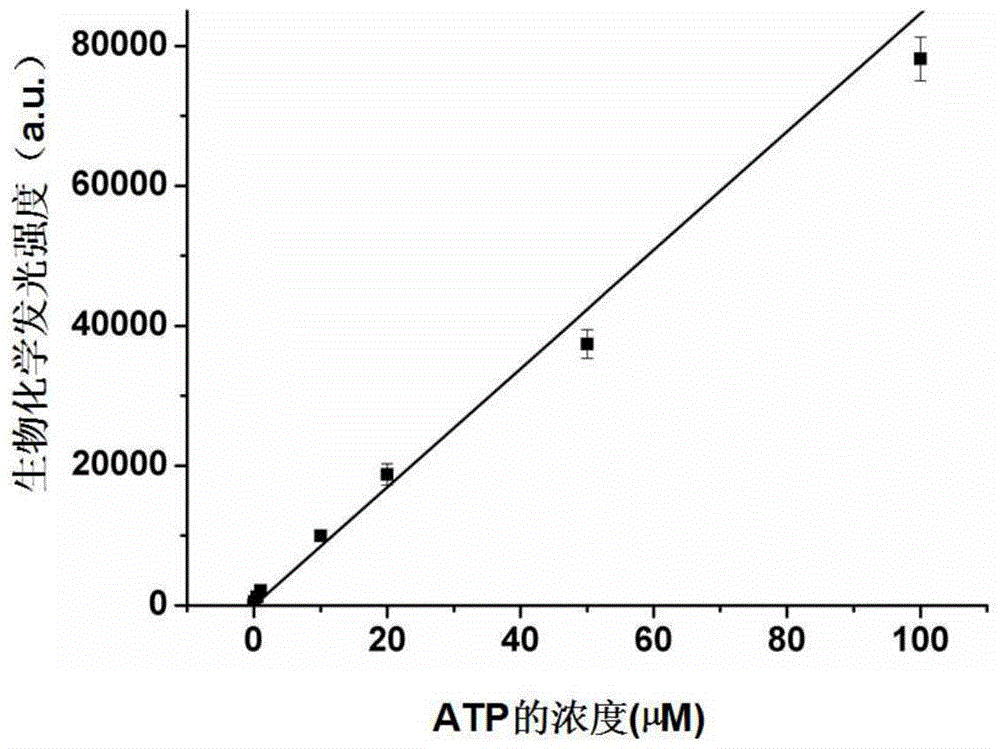Method for detecting alkaline phosphatase in body fluid
A phosphatase and alkaline technology, applied to the detection of alkaline phosphatase in body fluids, based on the field of bioluminescence quantitative detection of alkaline phosphatase, can solve the problems of high price, high analysis cost, interference with enzyme and substrate reactions, etc., to achieve Improve sensitivity and accuracy, strong anti-interference ability, and high sensitivity
- Summary
- Abstract
- Description
- Claims
- Application Information
AI Technical Summary
Problems solved by technology
Method used
Image
Examples
Embodiment 1
[0049] Detection of Alkaline Phosphatase in Serum by Bioluminescence
[0050] (1) Dilute the serum of normal people 10 times with pure water, and then add a series of alkaline phosphatase with different concentrations to the serum, so that the final concentrations are 7.5×10 -2 , 3.75×10 -2 , 7.5×10 -3 , 3.75×10 -3 , 7.5×10 -4 , 3.75×10 -4 , 7.5×10 -5 , 3.75×10 -5 , 7.5×10 -6 , 3.75×10 7 and 1.85×10 -7 .
[0051] (2) Take 1000 μL of serum sample, add 100 μL of adenosine triphosphate solution to resuspend it, and react at 37°C for 30 minutes; then add 50 μL of bioluminescence reagent (luciferin and luciferase), and measure the bioluminescence value with a portable ATP detector .
[0052] With the concentration of alkaline phosphatase as the abscissa and the change in bioluminescence intensity as the ordinate, a standard curve is constructed. The content of unknown alkaline phosphatase in serum can be detected through the standard curve. figure 2 It can be seen that...
Embodiment 2
[0054] Linear relationship between ATP concentration and bioluminescence values
[0055] Dilute the adenosine triphosphate solution with Tris-HCl to a concentration of 0, 0.01, 0.1, 0.5, 1, 10, 20, 50 and 100 μM, take 50 μL of each concentration of adenosine triphosphate, and then add a bioluminescent reagent containing luciferase and luciferin. 50 μL of the reagent was mixed evenly, and the bioluminescence value was measured quickly with a portable ATP detector. Construct a standard curve based on the relationship between luminescence value and ATP concentration. The linear relationship between the concentration of ATP and the bioluminescence value is as follows image 3 shown, from image 3 It can be seen that with the increase of ATP concentration, the bioluminescence value becomes larger with a good linear relationship.
Embodiment 3
[0057] The relationship between the content of alkaline phosphatase and the change of bioluminescence value
[0058] Dilute alkaline phosphatase with water to a concentration of 0,1.5×10 -5 , 3×10 -5 , 1.5×10 -4 , 3×10 -4 and 1.5×10 -3 U / mL, then take 100 μL of alkaline phosphatase dilution, then add 50 μL of ATP solution with a concentration of 50 μM and mix well, react in a 37°C incubator for 45 minutes, and finally add 50 μL of bioluminescent reagents and mix well, pass through a portable ATP detector Bioluminescence values were detected. from Figure 4 It can be seen that the method can detect 1.5×10 -5 U / mL alkaline phosphatase.
PUM
| Property | Measurement | Unit |
|---|---|---|
| Particle size | aaaaa | aaaaa |
| Specific saturation magnetization | aaaaa | aaaaa |
| Concentration | aaaaa | aaaaa |
Abstract
Description
Claims
Application Information
 Login to View More
Login to View More - R&D
- Intellectual Property
- Life Sciences
- Materials
- Tech Scout
- Unparalleled Data Quality
- Higher Quality Content
- 60% Fewer Hallucinations
Browse by: Latest US Patents, China's latest patents, Technical Efficacy Thesaurus, Application Domain, Technology Topic, Popular Technical Reports.
© 2025 PatSnap. All rights reserved.Legal|Privacy policy|Modern Slavery Act Transparency Statement|Sitemap|About US| Contact US: help@patsnap.com



